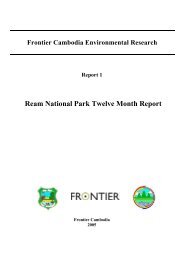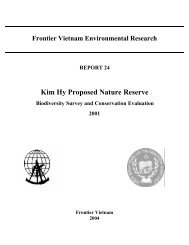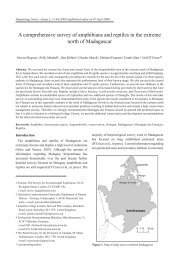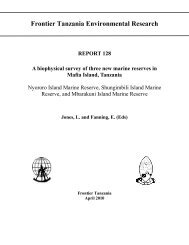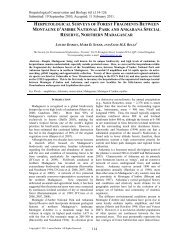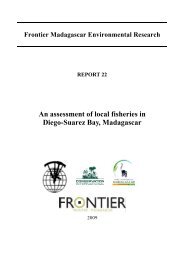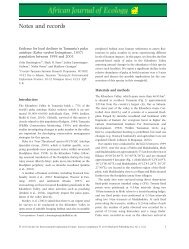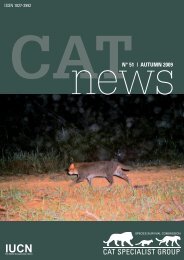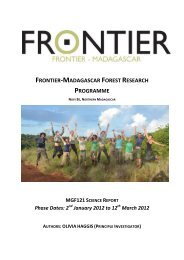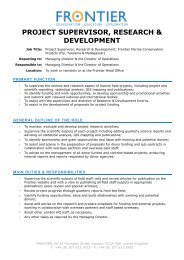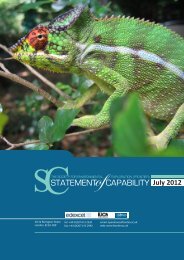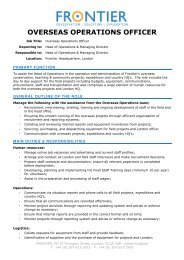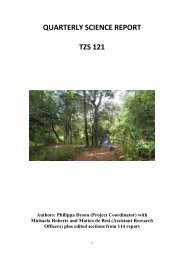Odonata of the Osa Peninsula - Frontier
Odonata of the Osa Peninsula - Frontier
Odonata of the Osa Peninsula - Frontier
Create successful ePaper yourself
Turn your PDF publications into a flip-book with our unique Google optimized e-Paper software.
Introduction<br />
Dragonflies (Insecta: <strong>Odonata</strong>) are amongst <strong>the</strong> most attractive and captivating groups <strong>of</strong><br />
insects. Their bright colors, aerial acrobatics, large body size and unique mating patterns<br />
capture everyone’s attention. In Latin America, a lack <strong>of</strong> field guides, active researchers and a<br />
widespread ignorance have caused this order to be understudied in comparison to o<strong>the</strong>r parts<br />
<strong>of</strong> <strong>the</strong> world. In a world where land managers are limited by a combination <strong>of</strong> time, money<br />
and personnel constraints, <strong>the</strong> use <strong>of</strong> secondary approaches to monitor biodiversity and detect<br />
change in habitat quality is essential. Dragonflies are excellent invertebrates to include in<br />
monitoring programs because <strong>of</strong> <strong>the</strong>ir usefulness as indicators for assessing both terrestrial<br />
and aquatic habitats (Schmidt, 1985; Corbet, 1993; Chovanec, 2000; Schindler et al. 2003).<br />
Dragonflies can be used as indicators <strong>of</strong> ecological health, ecological integrity, environmental<br />
change and <strong>the</strong> hydrological dynamics <strong>of</strong> water bodies (Clark and Samways, 1996; Moore<br />
1997; Chovanec and Waringer, 2001; Flenner and Sahlen, 2008). There are many advantages<br />
<strong>of</strong> using dragonflies as bioindicators (summarized by Chovanec and Waringer, 2001):<br />
� Advanced knowledge on <strong>the</strong> ecological requirements <strong>of</strong> a large number <strong>of</strong> Odonate<br />
species.<br />
� A high correlation between <strong>the</strong> presence <strong>of</strong> habitat components and <strong>the</strong> presence <strong>of</strong><br />
certain species.<br />
� A relatively small number <strong>of</strong> species (approximately 5.000 worldwide as opposed to<br />
100.000 species <strong>of</strong> butterflies. Esquivel, 2006) which can <strong>of</strong>ten be identified in <strong>the</strong><br />
field.<br />
� A relatively long ontogenetic development makes medium to long-term monitoring<br />
possible.<br />
� They react rapidly to a change in habitat quality by appearance/disappearance or by a<br />
change in abundance.<br />
� They serve as umbrella species representing both aquatic and terrestrial assemblages.<br />
Before <strong>the</strong> use <strong>of</strong> dragonflies can become a common practice in Central America, we need to<br />
fill some <strong>of</strong> <strong>the</strong> gaps in our current knowledge on this order. For example, little is known<br />
about <strong>the</strong> seasonal diversity, behavior, migration patterns and larva-adult associations <strong>of</strong> most<br />
species in this order (Esquivel, 2006). Thereby, very little region specific baseline inventory<br />
lists are published that can be used for conservation planning.<br />
In <strong>the</strong> present study, <strong>the</strong> dragonfly assemblage <strong>of</strong> a forest reserve owned by <strong>Osa</strong> Conservation<br />
on <strong>the</strong> <strong>Osa</strong> <strong>Peninsula</strong> in Costa Rica was studied with <strong>the</strong> overall aim <strong>of</strong> filling some <strong>of</strong> <strong>the</strong><br />
earlier described gaps in our knowledge <strong>of</strong> Central American <strong>Odonata</strong>. The objectives <strong>of</strong> this<br />
study are:<br />
1) To collect baseline presence/absence data to which future surveys can be compared to<br />
in order to detect changes in habitat quality that may have gone unnoticed by humans.<br />
2) To collect data on habitat use and seasonality.<br />
3) To create a photo ID guide <strong>of</strong> <strong>the</strong> species present in <strong>the</strong> area to facilitate future<br />
research efforts.



